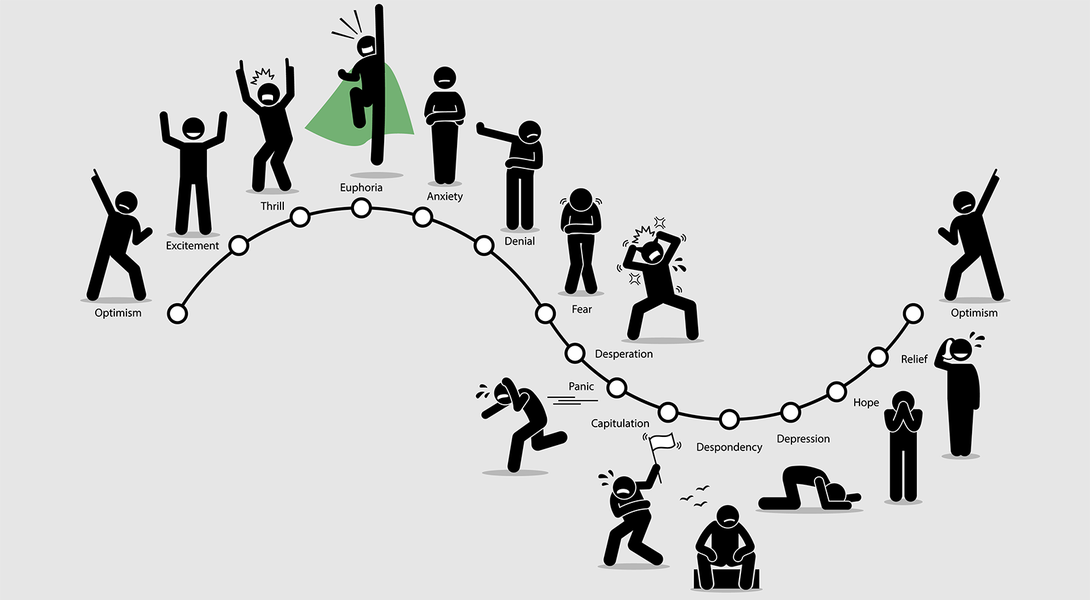A typical website project is an all or nothing affair, usually with a large investment of time, money and resources behind it, and then launched to the public.
The team works really hard to reach the end goal and celebrates a successful launch (Boom!). Then things fade out for a bit. If you’re lucky, it continues to be a focus and receive an investment of time and resources, but most likely, the website begins to age and become more and more outdated (Bust!).
Similar to the boom and bust of a stock market index, you may be seeing the same trendline of attention to your website. When you think of the start market, as a “boom” period begins, there is a sort of mild enthusiasm and the attention builds slowly. As you near the top of the market or site launch, it’s all hands on deck and all that anyone can think about. At some point, however, interest begins to wane once the project has launched or the market has hit its peak. The downward drift continues until it gets so low that it becomes the story. Just think of all the attention market crashes get — that’s the kind of attention that gets you fired.
Why is a “boom and bust” cycle bad?
You know what you think when you arrive on any website that’s lacking in some major things? Maybe it’s not responsive, for instance, or it looks like it was designed back in 2012 and doesn’t have much to offer. Those are perfect examples of a major website bust. The only things missing are tumbleweeds blowing across the screen.
It’s not usually that bad, of course. It might not even be the entire website and customer experience that are dated — it might only be the shopping cart or purchasing experience. Nevertheless, the interest level has moved on and previous projects have grown stale.
A “boom” cycle sounds great, right? Actually, no. That’s because bad things happen when people get crazy.
Let’s go back to our stock market example. During a boom, everything’s going up. No matter what you invest in, it’s all rising in price. Suddenly, there are financial wizards everywhere. Investors are making silly decisions because there aren’t any wrong answers, so the willingness to take on risk rises exponentially.
The same holds true for your site. When everyone is focused on building and testing, it’s easy. You’re getting lots of things done and crossing them off your to-do list But in reality, you’re rushing and failing to do due diligence on the decisions you’re making. Suddenly, your available resources shrink and your ability to use a smaller pool of resources to sustain the same level of attention just isn’t there. You start asking, “Why did we request these features?” or “This functionality is only half done… it can’t launch!” because you realize a portion of the team has had to move onto other projects or the money supply has dried up.
Your goal should always be to build that which can be both completed AND maintained. Remember, no matter what you’re launching, you’re going to need certain resources (e.g., time, money, and people) to keep it going.
Reviewing the boom and bust cycle gets to the heart of missing opportunities — whether you’re flying by them when things are busy during the boom cycle, or you’re slowly taking your attention and focus away after a big launch.
Cleaning up after booms and busts is expensive
When things get as bad as living in the “bust” cycle, they become very expensive to fix. Everything needs to be redone, updated, and reworked. It costs time and money to review a long list of neglected items and then rebuild or replace them. Keep in mind, too, that while you’re busy fixing, repairing, and replacing certain things, other things are likely to go wrong at the same time. (If you don’t believe us, then you’ve obviously never hired a plumber who accidentally puts a hole in your wall while trying to locate a leaking pipe).
After a boom period, you might notice that a lot of functionality has been built out that ended up being a total waste. You might find yourself asking, “Why did we demand this be added? We can’t support it.” We tell clients frequently to be honest with themselves on the amount of content that they can produce. In other words, don’t propose building widgets, launching a blog, and rewriting all of your sales copy, if you can only realistically do one of those things. An overly ambitious eCommerce project that looks great at launch will move into “bust” territory very rapidly.
When a bust happens, it means you’ve dug yourself into a very large pit. And getting out of that pit will cost you.
Planning is critical
Planning is such an important piece of the web development cycle that we preach about it constantly. Unfortunately, it’s also the piece that’s easiest to miss, especially what should come after launching. If there’s nothing after “launch” in your planning doc, then you’re doing it wrong. So let’s talk about doing it right.
Three things should be true when you’re launching anything:
- There’s always follow-up: Make sure you budget plenty of time to review the results of what you launch. Ideally, you should identify and map out measurables. The added benefit of doing this? As you analyze your post-launch measurables, you begin to fill up your “what’s next” list (we’ll get to that in a minute).
- Your “we’ll get to it after launch” list backlog: There should always be something in the backlog, regardless of the size. It could be a feature, tweak, change, or something that you just couldn’t get to before launching.
- What’s next = backlog + follow-up: Your backlog is the list of tasks you wanted to get to before launching, but couldn’t. But that list should also include the tasks generated by the ongoing “follow-up”. You can expect your list to be fluid and dynamic because it should continue to grow and be adjusted over time.
The exact plan you’ll need to adopt will come from your “what’s next” list. If your follow-up projects are buried behind a backlog or completely ignored as a result of new work, your entire project will be heading toward a bust.
Budgeting and priorities? Do you need a retainer?
OK, so let’s assume we’ve sold you on the idea that your eCommerce development, rework, and redesign cycle needs continuous review and reinvestment. How, exactly, do you plan for the money you’ll need to invest?
That depends on the types of investment you’ll need to make. When you’re reviewing an eCommerce budget, the best way to tackle it is to look at the total money (or resources) available and then subtract a maintenance number (understanding that the maintenance number may need to be adjusted based on results).
For example:
Total For New Projects = Total $ Available – Maintenance $
If you’re unsure what your maintenance number should be, just apply historical trends or set a ballpark to use a guide. As an example in simple numbers:
$10,000 monthly budget ($120k yearly)
20% Maintenance ($2,000 / 24k yearly)
Alternatively, you can assume an ongoing percentage based on the initial project cost.
| Total Project Cost | $200,000 |
| Maintenance Percentage (Annual) | 40% |
| Post-Launch Maintenance | $80,000 |
In the example above, the follow-up and maintenance spend might decrease over time, giving you the opportunity to allocate any savings to new projects.
| Months From Launch | Maintenance Spend |
| 1 & 2 | $40,000 |
| 3 & 4 | $15,000 |
| 5 & 6 | $15,000 |
| 7 & 8 | $10,000 |
| 9 – 12 | $10,000 |
How far ahead should you plan?
The simple (and unhelpful) answer is that it depends. The size of your “what’s next” list should give you some gauge on the amount of work that’s already in some form of planning. The larger your backlog list is, the more planning you need to do. In addition, one of the more important pieces of planning and scheduling is reworking the priorities of those items. That’s because priorities will likely shift constantly, based on the results you’re seeing after analysis and the available time resource you’re working with.
Keep in mind that any upcoming company milestones (e.g., new product lines, business expansions, etc.) will also factor into your scheduling and planning.
Conclusion and key takeaways:
- A launch isn’t the end — it’s the end of the launch process.
- Planning for investment in maintenance and rework is important.
- If you launch and forget, the investment to fix everything down the line is going to be daunting.
- Continually review your projects and work that review into your “what’s next” list.


